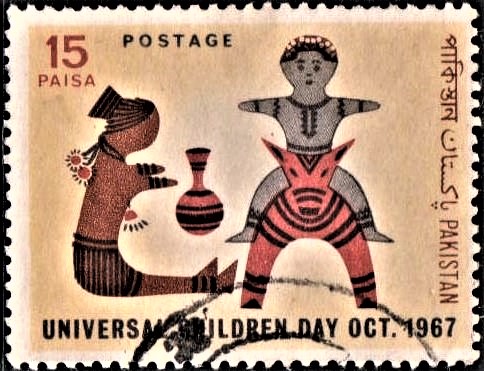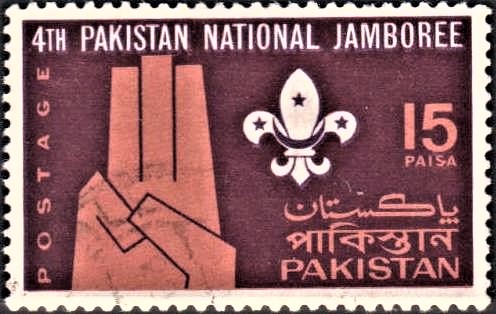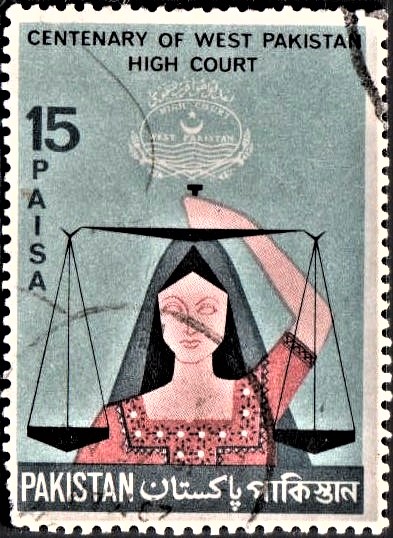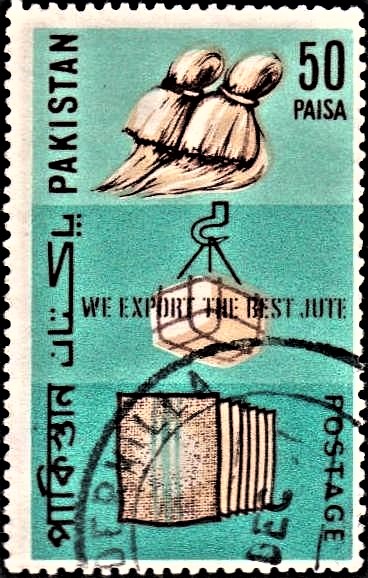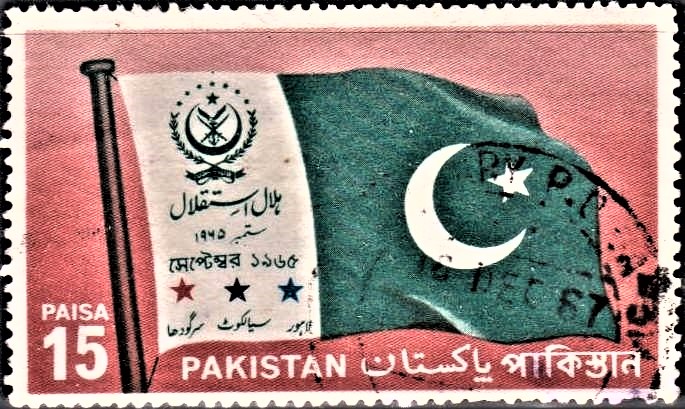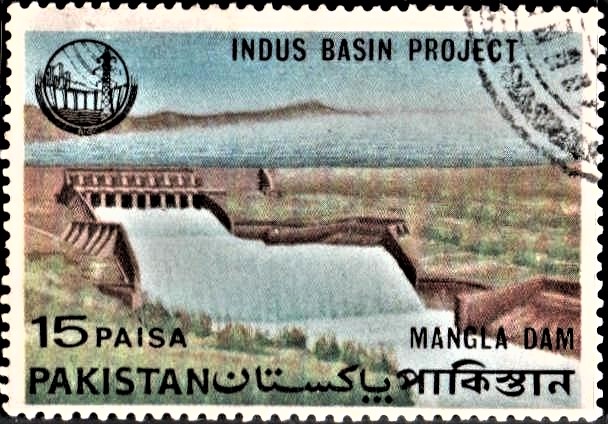
Pakistan on Indus Basin Project
A commemorative postage stamp on the Inauguration of the Mangla Dam :
 Issued by Pakistan
Issued by Pakistan
Issued on Nov 23, 1967
Issued for : Pakistan Post Office is issuing a Postage Stamp of 15 Paisa denomination on November 23, 1967 to commemorate the inauguration of Mangla Dam which forms a major part of the Indus Basin Project. The Indus Basin Project is an integrated system of water control works, known as the Replacement Works, based on the Indus Waters Treaty 1960, between Pakistan and India, which resolved the Indus Water Dispute.
Design : The design shows the spill-way with water gushing through the sluice gates. In the background is the vast lake merging into the horizon. The insignia of WAPDA and the words “INDUS BASIN PROJECT” appear at the head of the stamp printed in black. The denomination “15 Paisa” and the words “MANGLA DAM” appear at the foot of the stamp immediately above the word “PAKISTAN” printed in English, Urdu and Bengali.
Type : Stamp, Postal Used
Denomination : 15 Paisa
Colour : Yellow, Blue, Red and Black
Size of Stamp : 50.8 x 35.2 mm.
Size of Print : 47.5 x 32.2 mm.
Perforation Gauge : 13 x 13(c)
Quantity Printed : 15,00,000
Number of Stamps in each sheet : 50
Process of Printing : Litho Offset
Printers : The Pakistan Security Printing Corporation Ltd., Karachi
About :
- Nine years of negotiations between India and Pakistan preceded the signing of the Indus Waters Treaty, through the good offices of the World Bank for the completion of the Replacement Works. The signatories to the Indus Basin Development Fund Agreement were the Governments of Australia, Canada, Germany, India, New Zealand, Pakistan, U.K., U.S.A., and the International Bank for Reconstruction and Development (World Bank).
- The Treaty entitled India to the exclusive use of the three eastern rivers viz. Ravi, Sutlej and Beas and Pakistan, to the three western rivers viz. Indus, Jhelum and Chenab – except for some specified uses of the waters in the state of Occupied Jammu and Kashmir. The Treaty gave Pakistan a period of ten years to develop a system of works known as the Replacement Works, for the transference of waters, from the western to the eastern rivers.
- The Indus Basin Project, is likely to cost Rs. 1,041 crores and would consist of two storage reservoirs, Mangla on river Jhelum, and Tarbela on river Indus, with a total gross capacity of 17 million acre feet; a hydro-electric plant at Mangla with an initial installation of 400,000 kilowatts and ultimate potential of one million kilowatts; six barrages, including one gated syphon, having a total strength of 17,600 feet (over three miles) and with a total discharge capability in excess of 5 million Cusecs; and four link canal systems, comprising eight canals, totalling 700 miles in length and having a combined transfer capacity of 63,700 cubic feet per second. The link canals would be Trimmu-Sidhnai, Sidhnai-Mailsi, Mailsi-Bahawal, Rasul-Qadirabad, Qadirabad-Balloki, Balloki-Suleimanki, Chashma-Jhelum and Taunsa-Panjnad. The barrages would be at Sidhnai on the Ravi; at Qadirabad on the Chenab; at Rasul on the Jhelum; at Marala on the Chenab; at Chashma on the Indus and one gated syphon at Mailsi on the Sutlej.
- The remodelling of some existing works had also to be undertaken within the framework of the Project to fully integrate the new system of works with the extensive irrigation network already in service. These works include improvements in the Balloki-Suleimanki Link I, Marala-Ravi Link, Bombanwala-Ravi-Bedian-Dipalpur Link, the headworks at Balloki and Trimmu and the canal system of Dipalpur, Fordwah, Pakpattan, Mailsi, Bahawal and Sidhnai.
- As regards the overall progress on the Indus Basin Project as a whole, Mangla Dam which is the major component has been completed. Out of the eight link canals, the Trimmu-Sidhnai, Sidhnai-Mailsi, Mailsi-Bahawal, and Qadirabad-Balloki have been completed and are in operation. The Rasul-Qadirabad, Balloki-Suleimanki II and the Taunsa-Panjnad are in various stages of completion whereas work on the Chashma-Jhelum link has been started and it will be completed simultaneously with the Chashma Barrage.
- Work has also started on the Tarbela Dam Project in right earnest. Tenders for its construction are due to be opened on 30th November, 1967. Tarbela Dam will have storage capacity of 11.1 million acre feet and initial installed capacity of 7 lakh kilowatts which will ultimately be raised to 21 lakh kilowatts. It is scheduled for completion by 1976.
- Sidhnai Barrage, the Mailsi Syphon and the Qadirabad Barrage have been completed and are in operation; the Rasul and Marala Barrages will be in operation by early next year and work on the Chashma Barrage, the last of the barrages, has been started and it is scheduled for completion by the 31st March, 1971.
- Mangla Dam
- One of the largest dam in the world, Mangla Dam is a rolled earthfill embankment with a length of approximately 11,000 feet and a height of 380 feet above the river bed. The gross storage capacity of the dam has been estimated at 5.55 million acre feet and the live capacity 4.75 million acre feet. The design, however, provides for the raising of the dam by 40 feet in the future. This will increase the storage capacity to 9.4 million acre feet which will bring new lands under cultivation and reclamation. Owing to sedimentation, it is estimated that the life of the Mangla Dam reservoir will be limited to about 125 years, but this will be increased to about 250 years after raising the dam by 40 feet and through the watershed management measures being adopted in the catchment area of river Jhelum to check the heavy incidence of siltation in order to prolong the life of the Mangla reservoir.
- Estimated to cost Rs. 2,660 million (Rs. 3,160 million including Resettlement), the major constituents of the Mangla Dam are: Main Dam which is 11,000 feet long and 380 feet high at stage I and 420 feet at stage II; Jari Dam which is 5,700 feet long and 234 feet high; Sukian Dyke 17,000 feet in length and 80 feet in height; Main Spillway with a capacity of 900,000 cusecs; Emergency Spillway; Intake Area; Bong Canal 15,000 feet long 100 feet wide and 37 feet deep with a capacity of 40,000 cusecs; Power House with a capacity of 400,000 kilowatts at Stage I and 800,000 kilowatts at Stage II; Resettlement Operations; New Mirpur Town; and Watershed Management Operations.
- Power Station
- Mangla Dam has five diversion tunnels, each of 30 feet diameter, which can be used as intake tunnels to the power station and the irrigation valves. At present four power units capable of generating 100 MW each are being installed on two tunnels. Use of the remaining tunnels for power generation will be made as and when required. There will be 10 units in the ultimate installation with a total capacity of one million kilowatts. At present 200,000 kilowatts of energy is being produced by the two units. On completion the Mangla hydro-electric power station will go a long way in meeting the growing demand of electric energy in West Pakistan which is estimated to shoot up to 1.7 million kilowatts by 1975.
- With a 40-mile long lake of the reservoir extending over an area of 100 square miles and its gross storage capacity being 5.88 million acre feet (later on to be increased to 9.4 million acre feet) Mangla Dam, which is mainly a Replacement work, will, in the first instance serve the irrigational needs of about 30 lakh acres of land, as envisaged in the Indus Basin Plan.
- Resettlement Operations
- The 40-mile long reservoir created by Mangla Dam has sub-merged old Mirpur Town, 200 villages and 65,100 acres of land lying in Azad Kashmir and West Pakistan territories. About 20,000 families comprising about 100,000 souls were evacuated. About 3,699 families were allotted lands in the old colony districts of the former Punjab, 199 families in Taunsa Barrage area, 33 in Thal and about 900 families in the Gudu Barrage by the end of June 1967. Cash compensation was paid for built-up property and every type of other immovable property including trees. The total estimated cost of the Resettlement Operations works out to be about Rs. 500 million.
- New Mirpur Town
- Situated about four miles south of the Old Mirpur Town, on the eastern slopes of the Bala Gala ridge, New Mirpur Town, built in place of the Old Mirpur Town, which has been submerged under the waters of the Jhelum, is a beautiful modern city on the periphery of the Mangla Lake.
- It has accommodation for a population of over 20,000 people and is equipped with all modern civic amenities. It has 101 bungalows, 581 quarters, 4 middle schools, one K.G. school, one higher secondary school, one degree college, district courts, Government offices and police buildings, officers’ club, C.M.H. Jamia mosque, municipal office, animal husbandry, military stores, tonga stand, slaughter house, mohallah and town mosques, Imam Baras and jail buildings etc.
- Great Land-mark
- The Indus Basin Project though, in the first instance, a Replacement work is a great land-mark in the annals of development. Besides assuring water supply to areas which were previously served by the waters of the eastern rivers, the Sutlej, the Ravi and the Beas which will be cut off by India after 1970, this project will increase the irrigation and power potential and thus help the agricultural and industrial development of this country. Besides providing various other benefits in the form of improved means of communications, greater employment opportunities for various categories of workers, skilled and un-skilled, it has enabled thousands of Pakistanis to learn new skills and trades and their outlook has been enlarged. As such this Project and its completion has given us greater confidence to face greater challenges in the years to come.
- The successful handling of this task of colossal diversions bears testimony to the great engineering and organisational skill of those responsible for its completion and the spirit of co-operation and goodwill that prevailed amongst the workers of different nationalities who worked together for the realisation of the common goal of peace and progress.
- With the compliments of the Director General, Pakistan Post Office, Karachi.


